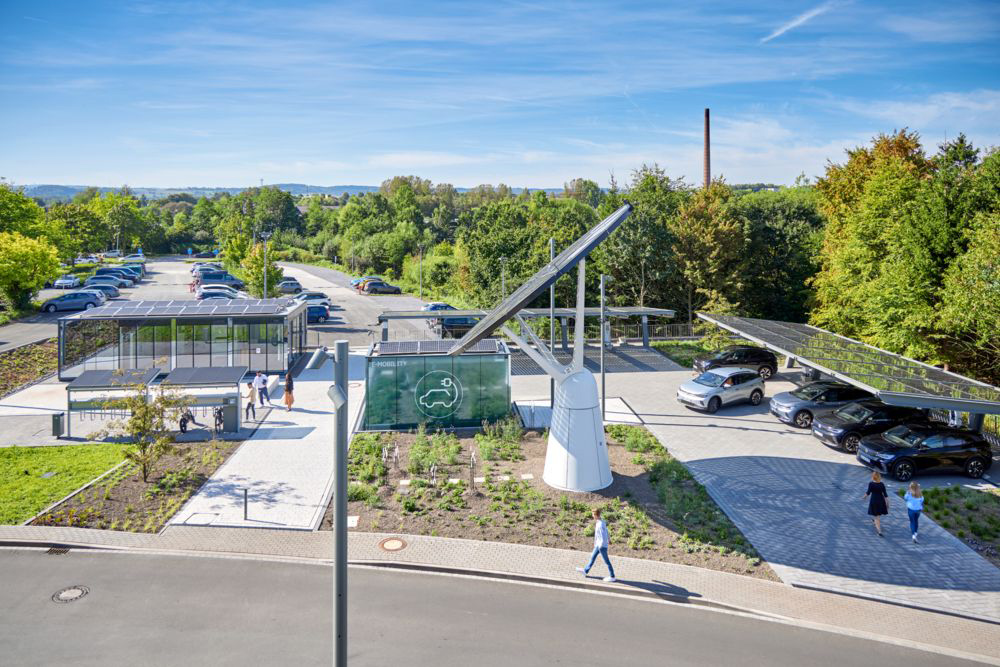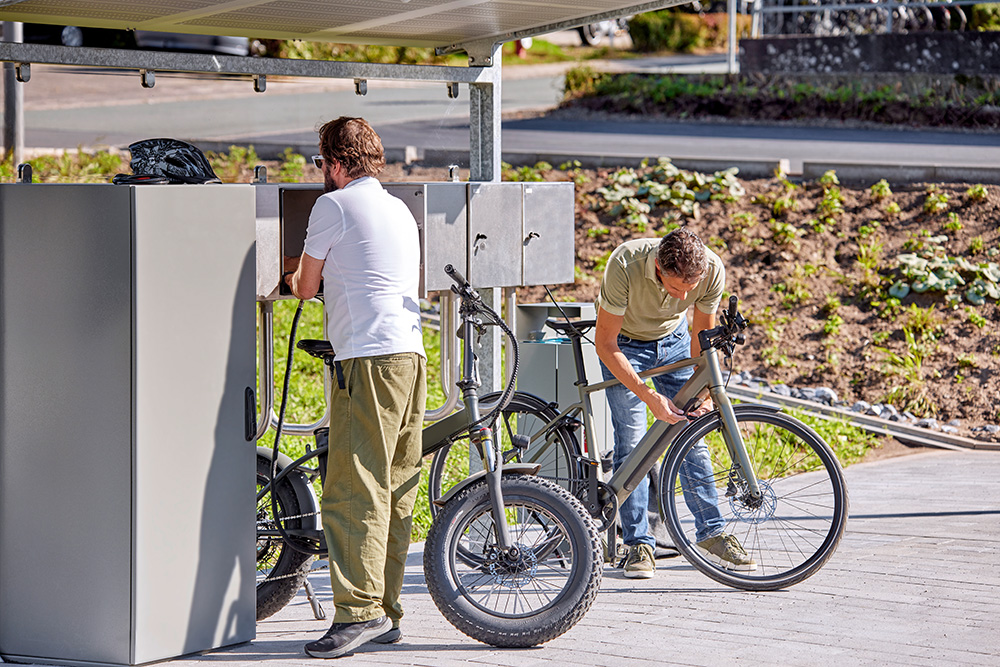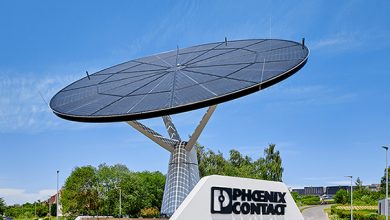Plug in, charge, unplug, drive off – it’s quite simple, isn’t it? But to make it just as easy, there’s a lot going on in the background. The All Electric Society Park reveals in detail how e-mobility actually works …

Whether Tesla or e-bike – even buses can (test) charge at the All Electric Society Park. The requirement: everything has to be (almost) as easy as visiting a conventional filling station with diesel or petrol. Two different charging stations are available for the four-wheeled means of transport. Three of the slim energy dispensers are AC charging stations, each with two charging connections that feed the electric speedsters with alternating voltage. And that up to 22 kW. Of course, this takes a little time and is intended for longer stays at Phoenix Contact. But it is also easy on the battery, because slow charging does not stress the batteries.
Things go much faster when the DC charging stations come into play. The battery is charged to 80 percent of its capacity in just a few minutes. More than that makes little sense when charging with DC, because then the expensive vehicle battery suffers unnecessarily. Smartphones and electric vehicles are very similar in this respect. DC charging is therefore for a quick sip in between. The six DC charging stations naturally make use of all of Phoenix Contact’s expertise. Thicker cables, larger plugs, cooled and award-winning, adorned with the logo and the “HPC” (for High Power Charging) label. This provides users with up to 350 kW of charging power.
Innovation from Blomberg
“Phoenix Contact does not manufacture its own charging stations. But here at the All Electric Society Park, we wanted to set up self-developed columns where we can show the use of our components in a charging station via a glass cover.” Andreas Diekmann has been with Phoenix Contact since 2011 and has been responsible for the hardware development of and for charging stations, their grid connection and the associated control cabinet building since 2021. “And although we have almost all charging station components in our product portfolio, we still had quite a learning curve to actually be able to manufacture our own stations in such a short time.” The project team only had a very short 14 months from the decision to build to the installation and necessary safety tests – the schedules were correspondingly tight.
“And that was just one aspect of the whole topic of e-mobility here at the park,” adds Rolf Stanislawski. The Director of Facility Management at the Blomberg site is responsible for the wide range of infrastructure, from the company’s own vehicle fleet to access control, from plant security to special projects such as this park – the veteran Phoenix Contact veteran never gets bored. “But this park is something very special,” Stanislawski enthuses. “The enthusiasm and dedication with which the team has worked and continues to work closely together here, and from so many disciplines, has been and still is enormous.”
The two experts inspect the shafts for the power and communication connection cables that lead to each charging station. “The new DC charging stations are slim but tall.” Diekmann points upwards. “They fit easily under the elevated solar panels. But it’s going to be tight when it comes to installation.” Andreas Diekmann proudly points to the head end of the column: “The cable entry is something very special. Because the high charging power that is to be fed into the vehicle here requires thick cables. That’s why we have developed a cable management system that prevents the charging cables from lying on the floor. This makes handling the bulky cable much easier.” He enthusiastically demonstrates the innovative new development. And mentions almost casually that a patent has also been applied for. So Phoenix Contact is not just thinking about electrical connections and control technology, but is taking a holistic approach to e-mobility.
E-mobility warms you up
Together with Rolf Stanislawski, we cross Flachsmarktstrasse on our way to the All Electric Society Park pavilion. “Here in the control center, we can see exactly what power the six AC and six DC charging points are currently operating at,” Stanislawski explains. The roof terrace offers a panoramic view of the e-mobility area. In order to remain ideally aligned with the sun, the smaller of the two solar trackers moves almost imperceptibly. The e-mobility area is like a miniature version of the entire park. A dedicated battery storage system with 280 kW of stored energy ensures that even several fast charging stations at the same time do not cause the entire power grid to falter.



“But we haven’t just thought about the flow of electricity in the e-mobility sector,” Stanislawski points to the other side of the park, “we are also using the power dissipation generated during charging and feeding this heat into the cold local heating network. So this energy is not lost either.” The Facility Manager is certain: “This is exemplary, for example for charging parks on residential buildings. With ideas like the ones we have implemented here at the All Electric Society Park, electromobility will become even more attractive.”
Facts
- The fast charging stations can provide a maximum of 350 kilowatts of charging power
- 6 of the super-fast energy dispensers are available in the park
- 12 charging points for e-bikes
- 280 kilowatt hours memory capacity of the battery storage system






